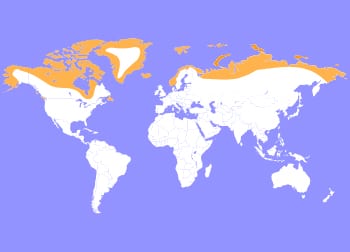Arctic Fox
Vulpes lagopus
Arctic Foxes are also known as the white fox, polar fox, or snow fox. Their most distinguishable quality is their snow white coat that helps them blend into their surroundings as a form of camouflage in the arctic tundra. This coat is extremely thick and warm, which has helped the fox to adapt to the freezing cold temperatures, as low as -60°F. In addition to its thick coat, the rounded body shape of the fox helps to insulate and trap heat inside. Arctic foxes live in burrows, and in a blizzard may tunnel into the snow to create shelter. To help prevent heat loss, they will curl up tightly tucking their legs and head under its body and behind its furry tail. While they do not hibernate, and are active year round, in the fall autumn season they build up fat reserves. This helps to have more insulation during the winter when food may be scarce. In the summer, arctic foxes will shed their winter coats for brown and and cream colored fur.
Arctic Foxes are known to be omnivorous, preying on small creatures such as voles, seal pups, fish, waterfowl, and sea birds. Lemmings are a staple in the Arctic fox diet, however they are opportunistic hunters and will sometimes scavenge leftovers of predators, such as polar bears! Carrion, berries, seaweed, insects and other small invertebrates make up the rest of their diet. They have a very sharp sense of smell, and their keen noses help them to detect seal lairs more than a mile away. Additionally their advanced hearing helps them to detect food under the surface of the icy tundra. When hunting they can be seen intently listening to the ground for movement, as they pounce down with the force of their paws to break the surface and find a meal.

Arctic Foxes have a circumpolar distribution that occurs in Arctic Tundra habitats; in northern Europe, northern Asia, and North America.
HABITAT -They inhabit the arctic tundra of the northern hemisphere, with chilling temperatures of -58°.
DIET -Omnivorous and opportunistic hunters. Lemmings are a staple in Arctic fox diet.
FUN FACT -Arctic foxes coats aren’t always white, in the summertime, their fur turns a brown or cream color.
SOCIAL BEHAVIOR -Live solitary lives, and will form monogamous breeding pairs, living in small family groups.
ACTIVITY -These foxes are mostly nocturnal, hunting at night. With some light activity during the day.
PREDATORS -In the arctic main predators of the arctic fox are polar bears, grizzly bears, golden eagles, and wolves.
SIZE -Arctic foxes can range anywhere from 1 - 2 feet, weighing 15 - 20 lbs.
RELATIVES - Vulpes genus has 12 species of foxes, all related to the Arctic fox (Red fox, Fennec fox).
CONSERVATION -Arctic foxes are considered Least Concern on the IUCN Red List.
Cub Creek Animal Care Information
Housing - Our arctic foxes inhabit ‘Fox Hollow’ all year round. This is a large outdoor enclosure, giving them plenty of space to run around and play. It’s covered in lush tall grass, you can see them running, jumping, and romping all around the area. We provide dens for sleeping, and automatic watering dispensers, always giving them a fresh supply of water. While not the arctic tundra, Missouri has cold winters of 26 degrees fahrenheit, lasting 5 months or more, simulating a natural winter environment. Our arctic foxes love to play around in the snow, showing off their beautiful coats in the winter time.
Diet - We feed our Arctic foxes Taste of the Wild high quality canine food. This food provides well rounded nutrition, with multiple sources of protein containing buffalo, lamb, bison, chicken, venison, fish, and eggs. Our foxes also enjoy special treats to supplement their diet such as scrambled eggs, mealworms and other invertebrates. They also enjoy the occasional “pinky” or “fuzzy” mouse!
Enrichment - Our foxes are as loveable and playful as your average domesticated dogs, they LOVE to play with their toys such as squeakers, kongs and rope toys. During the summer time, campers will make enrichment toys for them, using plush, cardboard, and premade toys. Along with spending time socializing them with helps to keep them stimulated and living a happy life!

